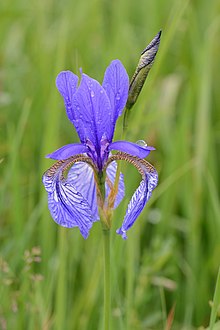Iris sibirica
| Iris sibirica | |
|---|---|
 |
|
| Iris sibirica | |
| Scientific classification | |
| Kingdom: | Plantae |
| (unranked): | Angiosperms |
| (unranked): | Monocots |
| Order: | Asparagales |
| Family: | Iridaceae |
| Subfamily: | Iridoideae |
| Tribe: | Irideae |
| Genus: | Iris |
| Subgenus: | Limniris |
| Series: | Iris series Sibiricae |
| Species: | I. sibirica |
| Binomial name | |
|
Iris sibirica L. |
|
| Synonyms | |
|
|
Iris sibirica, commonly known as Siberian iris or Siberian flag, is a species in the genus Iris. It is a rhizomatous herbaceous perennial, from Europe (including France, Italy, Switzerland, Austria, Czechoslovakia, Germany, Hungary, Poland, Romania, Bulgaria, Former Yugoslavia, Belarus, Estonia, Latvia, Lithuania, Moldova, Ukraine and northern Turkey) and Central Asia (including Armenia, Azerbaijan and Siberia). It has long green grass-like leaves, tall stem, 2–5 violet-blue, to blue, and occasionally white flowers. It is cultivated as an ornamental plant in temperate regions.
Iris sibirica was often confused with Iris sanguinea, another blue flowering Asian iris. But sanguinea has unbranched stems, while sibirica has branched stems.
It has creeping rhizome (approximately 0.9–1.2 cm (0–0 in) diameter), forming a dense clumping plant. The rhizomes are covered with the brown remnants of old leaves, from previous seasons.
It has green grass-like leaves, which are ribbed and can sometimes have a pink tinge at the base of the leaf. They can grow to between 25–80 cm (10–31 in) long and 0.4–0.6 cm (0–0 in) wide, normally shorter than the flowering stems. In Autumn, the foliage turns yellow and then dies back (in winter), to re-emerge in the spring.
It has a hollow, slender, 1–3 branched stem, that grows up to between 50–120 cm (20–47 in) long. The stems bear 2-5 (normally three) flowers, at the terminal ends between late spring and early summer, between May and June.
It has 3 brown paper-like spathes (leaves of the flower bud), that are reddish at the base, measuring between 3–5 cm (1–2 in) long.
The flowers come in a range of blue shades. From violet-blue, to blue, and occasionally white. The flowers are 6–7 cm (2–3 in) in diameter.
It has 2 pairs of petals, 3 large sepals (outer petals), known as the 'falls' and 3 inner, smaller petals (or tepals), known as the 'standards'. The drooping obovate falls, measuring 5-7.5 cm long and 2–2.5 cm wide, have a wide (or flaring) white blade or signal (central part of the petal) with dark-blue to violet veining. The white forms of the iris have a tinge of lavender and dark veining.
...
Wikipedia
